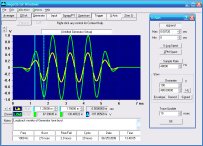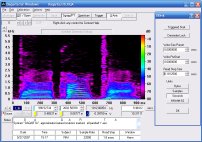![[LogoShip]](logo5.png)
Software for Windows
Science with your Sound Card!


Features:
Oscilloscope
Spectrum Analyzer
8-Channel
Signal Generator
(Absolutely FREE!)
Spectrogram
Pitch Tracker
Pitch-to-MIDI
DaqMusiq Generator
(Free Music... Forever!)
Engine Simulator
LCR Meter
Remote Operation
DC Measurements
True RMS Voltmeter
Sound Level Meter
Frequency Counter
Period
Event
Spectral Event
Temperature
Pressure
MHz Frequencies
Data Logger
Waveform Averager
Histogram
Post-Stimulus Time
Histogram (PSTH)
THD Meter
IMD Meter
Precision Phase Meter
Pulse Meter
Macro System
Multi-Trace Arrays
Trigger Controls
Auto-Calibration
Spectral Peak Track
Spectrum Limit Testing
Direct-to-Disk Recording
Accessibility
Data Logger
Waveform Averager
Histogram
Post-Stimulus Time
Histogram (PSTH)
THD Meter
IMD Meter
Precision Phase Meter
Pulse Meter
Macro System
Multi-Trace Arrays
Trigger Controls
Auto-Calibration
Spectral Peak Track
Spectrum Limit Testing
Direct-to-Disk Recording
Accessibility
Applications:
Frequency response
Distortion measurement
Speech and music
Microphone calibration
Loudspeaker test
Auditory phenomena
Musical instrument tuning
Animal sound
Evoked potentials
Rotating machinery
Automotive
Product test
Contact us about
your application!
Spectrum Analysis Frequency Resolution
In spectrum analysis, frequency resolution is controlled by the spacing of the reference frequencies that we use. For instance, if we want to resolve a 500 Hz input signal to within 1 Hz, that means we must get zero output from the average when the reference frequency is at 499 or 501 Hz. According to the sine product formula, the multiplier will give a component with a difference frequency of 1 Hz under these conditions.
We know that a sinusoid averages to zero due to symmetry, so we must average over at least one full cycle to take advantage of this. (In fact, if we are not going to average over a really long interval, we should always make sure we at least have an integer number of cycles.) The take-home message here is that the averaging interval must always be at least as long as the reciprocal of the desired frequency resolution. (1 sec for 1 Hz resolution, 0.1 sec for 10 Hz resolution, etc.)
In our Generator example, try setting AM Mod Freq to 501 Hz while Tone Freq is still 500 Hz. The product will show the expected 1001 Hz sum frequency, but the 1 Hz difference frequency will cause it to slowly ride up and down. A short-term average might catch this at a peak or valley, and would thus not give the desired zero output.
Several types of measuring instruments use these continuous Fourier Transform methods, including Wave Analyzers (now nearly extinct), Swept Spectrum Analyzers (still used for radio frequencies), and Lock-In Amplifiers (used for high resolution and sensitivity at single frequencies). But for most spectral analysis work at frequencies under about 1 MHz, digital methods now dominate. With rising signal processor speeds, digital methods will continue to conquer ever-higher frequency regions.
See also Spectrum (Fourier Transform) Theory
- Back to Practical Spectrum Analyzer
- Ahead to Sampled Data for the Discrete Fourier Transform
- Daqarta Help Contents
- Daqarta Help Index
- Daqarta Downloads
- Daqarta Home Page
- Purchase Daqarta
Questions? Comments? Contact us!
We respond to ALL inquiries, typically within 24 hrs.INTERSTELLAR RESEARCH:
Over 35 Years of Innovative Instrumentation
© Copyright 2007 - 2023 by Interstellar Research
All rights reserved